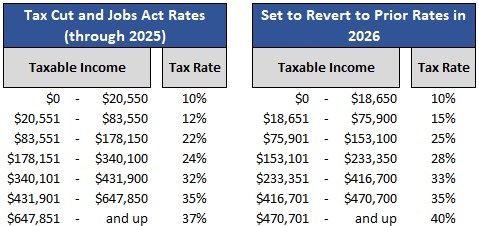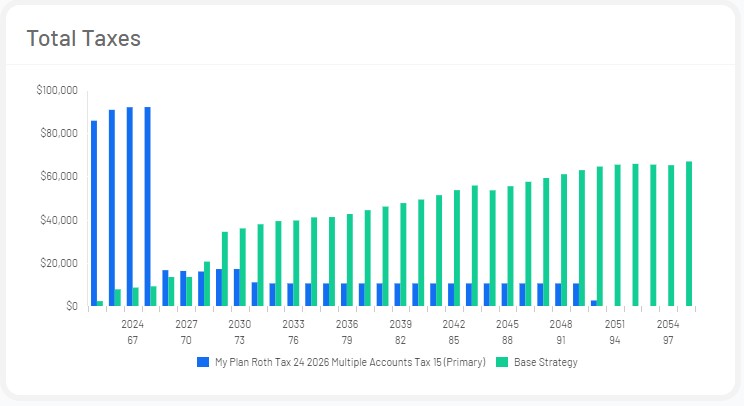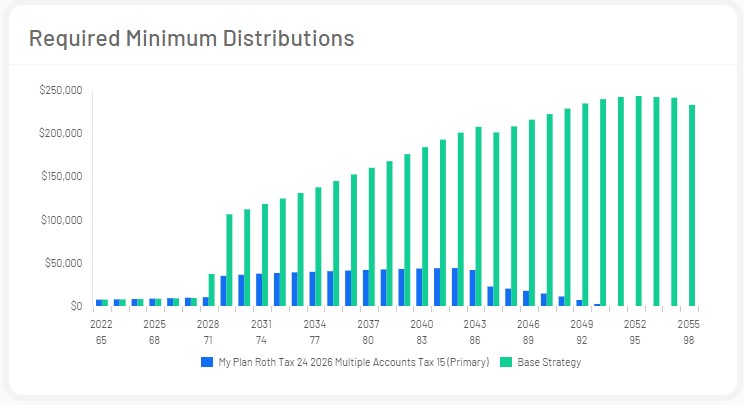
Don't Miss Your 2022 Roth IRA Conversion
A Roth conversion is the act of converting traditional IRA assets (or pre-tax 401k assets through a rollover IRA) to a Roth IRA. Any amount of IRA assets can be converted to a Roth IRA in any year, so long as you recognize the withdrawal amount as income in the year withdrawn and pay taxes according to your marginal income tax levels. While there are income limitations on contributing directly to a Roth IRA, there is no income limitation when it comes to converting traditional (or rollover) IRA assets to a Roth IRA.
Roth IRA conversions are a powerful retirement planning tool that can create value by itself as well as unlock many other valuable retirement planning strategies.
Current Lower Tax Rates Set to Expire at the End of 2025
One such factor aiding the math for many is that today's lower marginal income tax rates under the Tax Cut and Jobs Act are set to expire in 2026. At expiration, marginal tax rates are set to revert to the previous higher levels. The difference in married filing jointly personal marginal income tax rates and income thresholds is substantial and can be seen from the charts below:
Many individuals stand to benefit from a strategy of converting IRA assets in 2022, 2023, 2024, and 2025, realizing income up to at least their 24% income bracket (or $340,100 of taxable income). For example, the realized federal tax liability on $340,100 of taxable income in 2022 would be $69,264. In 2026, the realized federal income tax on $340,100 of taxable income would be $39,928 (or 58%) more, at $109,192. This substantial difference makes Roth converting in each of the next four years valuable in and of itself.
Other Benefits of Roth IRA Conversions
Aside from the obvious benefit of paying income taxes now at a lower rate than later at a higher rate, there are several less obvious but material benefits to a Roth IRA conversion strategy.
1). Tax Planning for Efficient Retirement Distributions
Having assets invested in a Roth IRA in addition to an IRA allows you to coordinate withdrawals later to keep yourself just under your highest marginal income tax bracket. For example (ignoring exemptions and other income), assume in 2026 you needed $100,000 from your IRA to help fund your living expenses. Your marginal income tax rate would be 25% if married filing jointly. You would pay 10% on your first $18,650, then 15% on the next $57,250, and finally 25% on your last $24,100. Altogether, your tax bill would be $16,478. But if you funded that last $24,100 from your Roth IRA instead of your traditional IRA, you would reduce your tax bill by 37% and save $6,025 (tax policy and inflation-adjusted) annually. Having sufficient assets in a Roth IRA allows you to create an optimal tax-efficient strategy of ongoing withdrawal coordination to minimize the amount of taxes you pay over your lifetime.
For example, we have a client that is Roth converting up to their 24% marginal income tax rate each year through 2025 so that beginning in 2026, they have enough money in their Roth IRAs that we can fund their $220,000 net retirement spending goal (requiring taxable income of almost $275,000) while keeping them under the 15% tax bracket. Following is a comparison of the couple’s estimated yearly tax liability under their Roth conversion strategy (in blue) and a no-Roth strategy (in green). The couple could stand to save almost $1,000,000 in taxes over 34 years.
2). Reduce Future Required Minimum Distributions (RMDs)
Another less obvious benefit of a properly constructed Roth IRA conversion strategy is that you can lower the amount of your future RMDs that begin at age 72. By converting your IRA assets to a Roth IRA, you reduce the amount of assets left in your traditional IRA accounts plus transfer the assets’ future growth. By lowering the amount of assets in your traditional IRA, you can lower your RMD to a level such that you do not have to recognize income and pay taxes on money that may not be needed. Reducing RMDs is also a key strategy to reducing your sequence of returns risk. (See our Insight entitled “Evaluating the Big Five Retirement Risks Every Retiree Faces” for more)
Carrying forward our previous example, the following compares the couple’s forecasted RMDs under their Roth conversion strategy (in blue) and a no-Roth strategy (in green).
3). Tax-Efficiently Passing Money on to Beneficiaries
A Roth IRA conversion strategy can also be used to tax-efficiently pass more wealth on to beneficiaries. If you were to leave your traditional IRA assets to your beneficiaries, they would have to withdraw the assets within ten years from the date of your death and pay income taxes on the amounts withdrawn in the years taken. There might be two problems with this. First, your beneficiaries might be in a higher marginal income tax bracket than you are, given they are still in their working years. Second, your beneficiaries will have to pay taxes on the assets' ten years of capital growth. If your beneficiaries are in higher marginal income tax brackets than you, paying taxes at your lower rate to convert the assets to a Roth IRA allows the assets to pass and not be taxed at your beneficiaries' higher tax rate later. Additionally, the assets can grow tax-free for ten years before your beneficiaries must withdraw the assets. The result could be additional material wealth being passed to your beneficiaries
4). Asset Location
Lastly, a Roth IRA account gives a more robust way to execute an investment management strategy known as Asset Location. The idea behind Asset Location is that it is advantageous to hold certain types of assets in certain types of accounts. You can view all of your assets and accounts as one aggregate portfolio. You do not have to create a balanced portfolio in every account. When viewed in this aggregate way, you can take advantage of the fact that capital growth assets, like stocks, are best held in Roth accounts. Why? Because stocks will grow fastest, and that growth will never again be taxed if held in a Roth IRA. Holding bonds in a Roth IRA account would be a waste of that account type's advantage. Income-producing assets, like bonds and REITs, are best held in retirement accounts, so their income distribution can grow tax-deferred rather than become immediately taxable as they would if held in a taxable account.
Developing a Roth IRA Conversion Strategy
There are many factors to consider in developing a Roth IRA conversion strategy, and the strategy must be constructed based on a couple’s (or individual’s) unique circumstances, resources, and goals. (See our Insight entitled “Developing a Retirement Income Strategy to Minimize Lifetime Taxes” for more)
Roth IRA Conversions Must Be Done Before End of Calendar Year
Contributions to an IRA or a Roth IRA are required by the end of the tax year, April 15th, the following year. For instance, the tax year for 2022 ends on April 15th, 2023. Unfortunately, Roth IRA conversions must be made before the end of the calendar year. For instance, the calendar year for 2022 ends December 31st, 2022.
Not only do Roth IRA conversion requests have to be completed before the end of the calendar year, but you also have to allow time to complete the necessary custodial paperwork and allow the custodian time to process the paperwork. Because custodians tend to get flooded with paperwork before year-end, we strive to have all client Roth conversion requests in by November 30th to ensure timely processing.
There is still time if you need help figuring out your optimal Roth IRA conversion strategy. We still have the capacity to take on a couple more clients this year. Please know our planning process takes approximately four to six weeks. To be sure we have an optimal Roth IRA strategy in place to execute by November 30th means getting started soon, so please do not delay if this is something you are ready to begin. To learn more, you can schedule a friendly, informal call for a date and time that is convenient for you here at this link: https://calendly.com/thriveretire/thriveretire-call or contact us here at any time.



